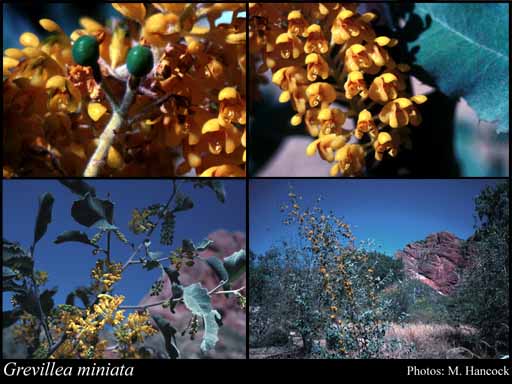- Reference
- The Western Mail 21:10 (1906)
- Conservation Code
- Priority Four
- Naturalised Status
- Native to Western Australia
- Name Status
- Current
Spreading to erect shrub or tree, 1.8-5 m high. Fl. yellow-orange, Apr or Jun to Aug. Skeletal sandy soils or sandy loam over quartzite or sandstone. Cliffs or rocky slopes, sometimes along watercourses.

Scientific Description
Shrubs, 2-4 m high; branchlets hairy, not glaucous. Leaves alternate, 55-115 mm long, 30-65 mm wide, hairy, on the adaxial or abaxial surface, the hairs straight; lamina flat, widest around the middle or more or less the same width throughout, once divided, pinnately divided, shallowly divided, the margins flat. Inflorescences axillary, green, yellow or red; pedicels 4-6 mm long. Perianth 9-12 mm long; tepals fused (at least at base) after flower opens, glabrous or hairy, glandular-hairy; ovary glabrous, stipitate, the stipe 3-4 mm long; pistil 8-12 mm long, yellow, pollen presenter lateral, style hairy. Follicles glabrous, not viscid, dehiscent, 14-18 mm long. Flowers in April, May, June, July or August. Occurs in the Northern (N) Botanical Province(s), in the Central Kimberley (CK) or Ord-Victoria Plains (OVP) IBRA subregion(s). : Conservation code Priority Four (P4).
Distribution
- IBRA Regions
- Central Kimberley, Ord Victoria Plain, Victoria Bonaparte.
- IBRA Subregions
- Pentecost, Purnululu.
- Local Government Areas (LGAs)
- Derby-West Kimberley, Halls Creek, Wyndham-East Kimberley.